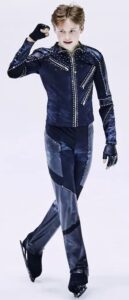 Teen male ice skating phenom Ilia Malinin (photo, left), 17, performed the sport’s last unconquered quad jump — the quadruple axel — at a Lake Placid competition (details here) on Thursday, September 15, 2022 (see story here and watch video below).
Teen male ice skating phenom Ilia Malinin (photo, left), 17, performed the sport’s last unconquered quad jump — the quadruple axel — at a Lake Placid competition (details here) on Thursday, September 15, 2022 (see story here and watch video below).
Generally speaking, doing a skating move in practice doesn’t count for the record books. It has to occur in competition, and also be reasonably “clean” (i.e., not sloppy). For a history of quad jumping, go here. The first one was done by Canadian skater Kurt Browning (bio here) in 1988, and shortly thereafter I saw him skate in Seattle and asked his coach how it was done. Getting four revolutions in the air after taking off from the ice is no easy feat.
It has to do with how fast your body spins, which is a function of how tight you pull your arms in to the body; and, of course, the leg strength propelling the takeoff and body spin. You also must set up the jump perfectly, or you won’t get the height and rotation speed needed for that many revolutions in the air (this is also true of triple jumps, skating’s gold standard until quads appeared).
This is true of skating spins, too; to speed up, you pull your arms in, and to slow down or stop the spin, you extend your arms out from the body.
Browning did a quad toe loop, arguably the easiest kind of jump to make. All skating jumps except the axel take off while skating backwards; the axel is the only jump with a forward-facing takeoff, and that makes it harder, because you have to do an extra one-half revolution. The double axel is 2½ revolutions in the air, the triple axel 3½ revolutions, and the quad axel 4½ revolutions.
Until today, no one had landed a 4½-revolution jump in competition. That Mount Everest has now been climbed, and it’s not surprising a teenager did it, as most skaters peak in their late teens, and the physical agility required for skating’s most difficult jumps begins to wane by the early 20s. This is why you don’t usually see skating champions who go on to professional skating careers perform their Olympic medal-winning moves in shows.
A handful of female skaters have done quads in competition. French skater Surya Bonaly was the first to seriously try, in the early 1990s, but didn’t quite pull it off (see video here).
This doesn’t mean there aren’t more skating Everests to climb. Combination jumps — two jumps in tandem, often a triple-triple or triple-double) — are standard fare in high-level skating competition; and while quad-triples have been done, a quad-quad and a women’s quad axel have yet to be done.
If history is any guide, they eventually will be. As in climbing mountains, the word “impossible” seems to no longer have any meaning. Through the years, as these sports have developed, better training and refining of technique have progressively made the impossible possible. And, of course, endless amounts of practice.